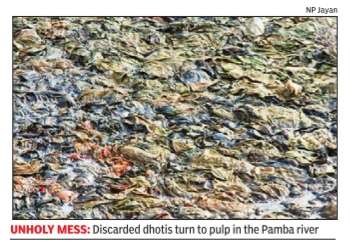Sabarimala
This is a collection of articles archived for the excellence of their content. |
Pollution, garbage, the environment
Sabarimala crush puts reserve at risk
Malini Nair
The Times of India Jun 22 2014
20L Pilgrims Trample Periyar’s Forests Every Your
From a distance, it is hard to figure out what the mess piled up on the banks of river Pamba is. The photograph is actually a surreal view of a sea of sodden dhotis abandoned by pilgrims as they end the hard trek to the Sabarimala shrine in Kerala.
This pile will soon degrade into pulp and join other junk and sewage waste that flows down this once pristine river that feeds the Periyar Tiger Reserve. This will include water bottles, oil drained from smashed coconut shells and other kinds of non-degradable rubbish. This is what you see at the end of the festive season of December and January every year when a staggering 20 lakh pilgrims trek through the forested landscape of Sabarimala.
Veteran wildlife photographer NP Jayan worked for two years in the region, documenting the massive damage to its environment. Of the 7,000 frames he clicked, 70 are being mounted at the India International Centre in Delhi at a photo show titled Thathwamasi, Eye on the Periyar Tiger Reserve and Sabarimala.
“Every route is littered with piles of refuse. The facilities here cannot even cope with 10 lakh pilgrims and we get 35 lakh on the final day,“ says Jayan.
Regulation of pilgrimages is a sensitive issue for obvious reasons but it is becoming increasingly difficult to ignore the devastation caused by excessive flow of the devout to India’s tirth yatras. Many such sacred sites are located in the midst of nature — rivers, mountains and forests were protected because they were hard to access. Sabarimala itself is called a ‘kanana kshetram’ (forest temple), where the flora and fauna are as sacred as the shrine itself. “You cannot treat it like a popular urban temple. You cannot build concrete structures, roads and helipads and change it undamental concept,” says former forest minister Binoy Viswam.
“The Travancore Devaswom Board seems to be only concerned with awarding of contracts.” Environmentalists fear a disaster like Kedarnath. Environmentalists fear a disaster like Kedarnath. Experts believe the Himalayan tragedy was the result of excessive construction to cater to pilgrim needs. The Periyar forest reserve, known for its rich biodiversity, is threatened by rampant development. “There are few tiger sightings here now,” Jayan says,.
There was a time when Sabarimala was a tough pilgrimage. It wound through difficult terrain inhabited by predators, and young women were not allowed entry. Today, access is easy, authorities have eased the ordeals, and the route is littered with shacks. This pulls pilgrims from across the country. “The authorities seem wary of offending the bhaktas,” says Jayan.
In early 2014, the decaying carcass of an elephant was found here. He had ingested kilos of plastic waste. So far only plastic bags were banned inside the temple. There is now a call to extend the ban to all plastics.
“It is now up to devotees to step up and take care of the temple’s environment,” says Viswam.
HC bans use of elephants at Sabarimala temple
The Times of India, June 3, 2016
